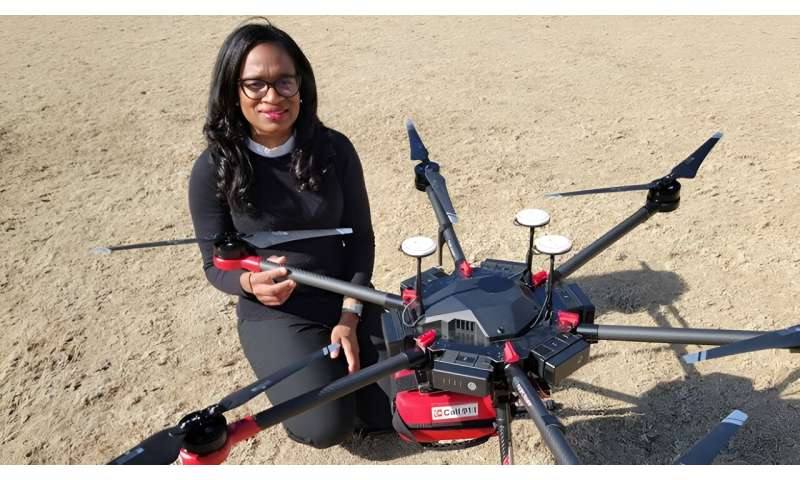To the rescue: Drones could deliver defibrillators for out-of-hospital cardiac arrests

When you look to the sky these days, you never know what you might see—a bird, a plane, a shooting star, or…a drone carrying an automated external defibrillator (AED)?
That's right: A medical drone.
A team of researchers is testing drones to deliver AEDs that can be used to help quickly revive people who've had an out-of-hospital cardiac arrest (OHCA), a leading cause of death in the United States and worldwide. Each year in the U.S. alone, about 350,000 OHCAs occur, and they are almost always fatal: only about 10% of victims survive.
Studies show that survival rates improve greatly if defibrillation—delivering an electric shock to revive the heart—occurs in the first 5 minutes following cardiac arrest. Bystander use of AEDs, performed in conjunction with cardiopulmonary resuscitation (CPR), is associated with the best odds of survival. However, bystander use of AEDs remains extremely low—about 4% nationwide—in part because the devices aren't readily available in most places.
Monique Starks, M.D., a cardiologist and NHLBI-supported researcher with Duke University School of Medicine in Durham, North Carolina, is working to change that. And if her studies prove beneficial, she said, a drone may be coming to a house or farm near you in just a few years.
"Drone delivery of AEDs is a potential game-changer in cardiac arrest in the United States," Starks said. "Drone technology can put AEDs directly in the hands of bystanders, who can use them to treat cardiac arrests much faster than waiting for emergency responders to arrive."
She and her research team have used mathematical simulation models to test the feasibility of drone use for AED delivery, using data from 28,292 cardiac arrests that occurred in 48 North Carolina counties between 2013 and 2018. Her modeling studies have shown that the median time from the 9-1-1 call to AED arrival can be reduced from 8 minutes to just under 5 minutes with drones—within the critical window for survival and nearly double the speed of emergency responders equipped with an AED.
Importantly, those studies also show that an optimized drone network in the area—about 326 drones spread across all 48 counties—could boost survival by as much as 34%.
"We're on a mission to improve outcomes of out-of-hospital cardiac arrests and drone technology with AED delivery holds significant promise for moving that needle," Starks said.
Here's how it would work. Imagine that a person living on a rural farm has a sudden cardiac arrest. A bystander who witnessed the event would ideally call 9-1-1 and begin CPR immediately. At the same time that telecommunicators instruct the bystander to begin CPR, they activate an emergency system that would send first responder vehicles, an ambulance, and a drone-equipped AED to the scene via simultaneous alerts.
The drone, about the size of large suitcase, would then fly from the closest launch site (which could be several miles) to the cardiac arrest scene and lower the AED from about 125 feet in the air using a tether or rope. The bystander would then retrieve and use the AED to restore the victim's heart rhythm and hopefully save their life. The drone would then return to its launch base and get re-equipped for its next mission.
Nicole Redmond, M.D., Ph.D., M.P.H., a NHLBI program officer and chief of the Clinical Applications and Prevention branch in NHLBI's Division of Cardiovascular Sciences, said that in addition to speeding delivery of AEDs to where they are needed most, the drone can do something else: help reduce geographic disparities in the treatment of OHCAs.
"We see AED devices at offices and stadiums in larger urban areas, but not as frequently in rural and remote areas," Redmond said. "But cardiac arrest can happen anywhere. Being able to deploy those devices on-demand via drone to areas where they are lacking could make a big difference."
In the meantime, Starks' research team is planning pilot studies using a network of AED-equipped drones in Forsyth County, North Carolina, and James City County, Virginia. Ultimately, she hopes to test the safety and effectiveness of drone AED delivery in large scale trials to ensure safety and effectiveness. If successful, she envisions these medical drones eventually being used nationwide.
But creating a successful medical drone network won't be easy, she conceded. Challenges include Federal Aviation Administration (FAA) regulations, costs, community support, integration of the system into current emergency response networks, and a lack of bystander training on AED use. Starks and other experts believe these challenges can be overcome, however.
"I think it's a great idea, especially in rural areas and hard-to-reach geographic areas," said George Sopko, M.D., M.P.H., program director of the resuscitation branch of NHLBI's Division of Cardiovascular Sciences and a medical officer. "Minutes matter, and anytime you can get ahead of the game, you'll save lives."
According to Sopko, drones are part of a growing number of advances—new drugs, improved CPR techniques, and better technologies—that are helping increase survival for cardiac arrest victims.
"Resuscitation success is improving," Sopko said, "but we've got to educate and train the public more in the proper use of CPR." This includes how to administer chest compressions, ventilations (breaths), and AEDs, he said, adding that as techniques change and improve, people must be retrained.
"We're getting there, but we have a ways to go."
Provided by NIH/National Heart, Lung and Blood Institute